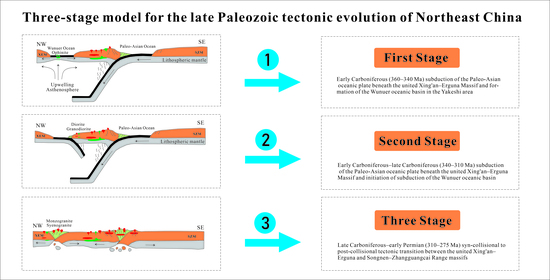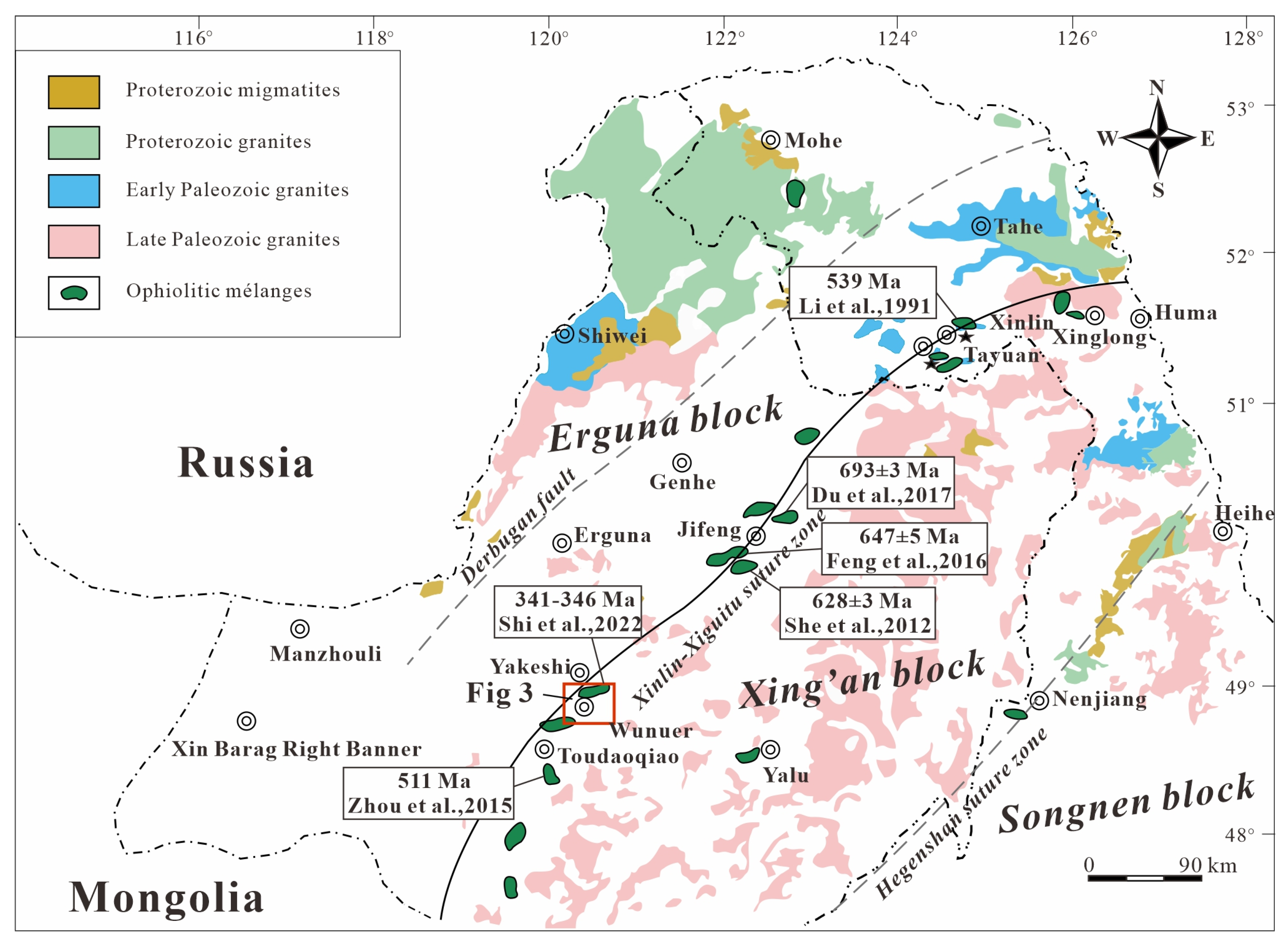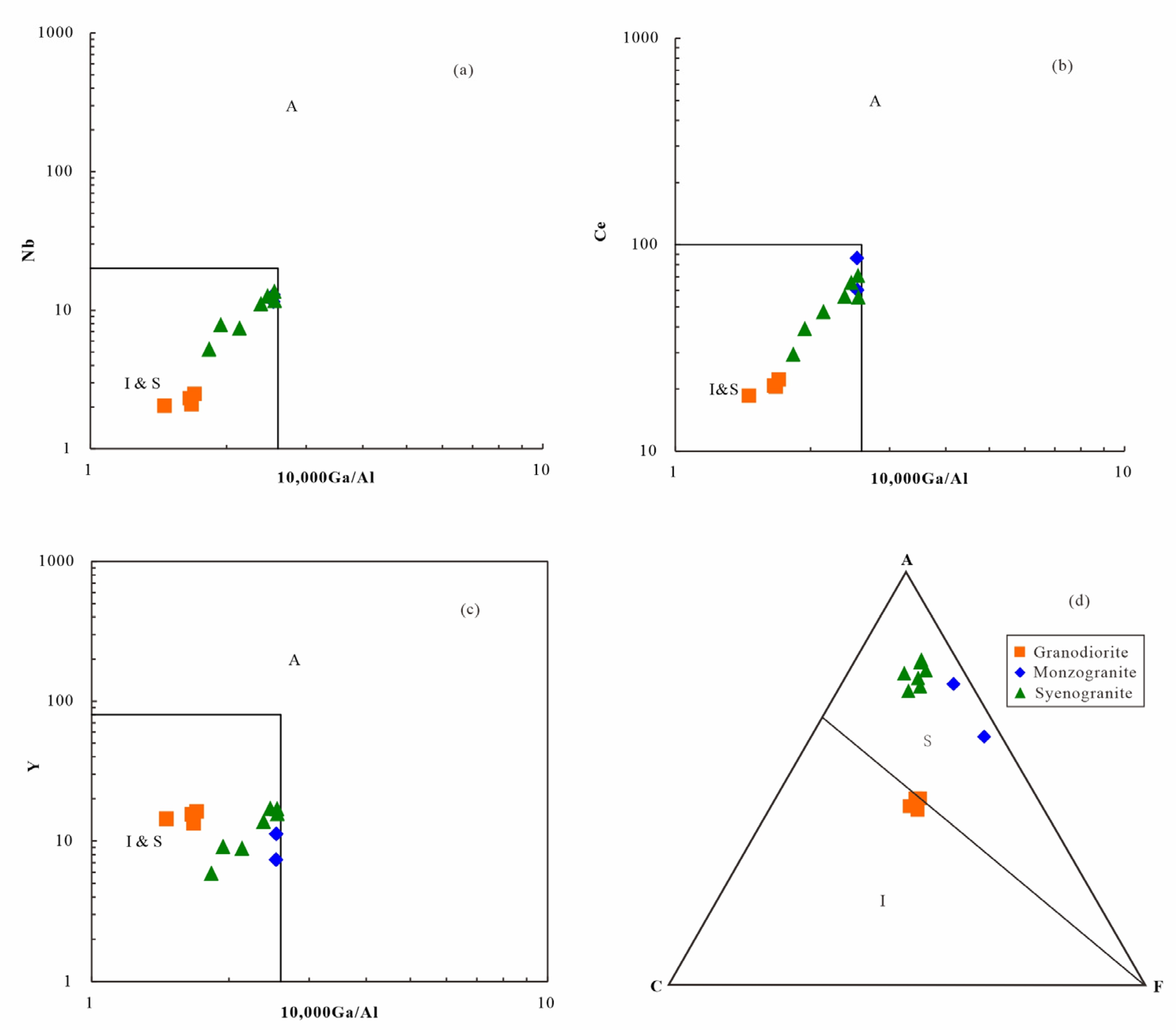Late Paleozoic Tectonic Evolution of the Northern Great Xing’an Range, Northeast China: Constraints from Carboniferous Magmatic Rocks in the Wunuer Area
Abstract
1. Introduction
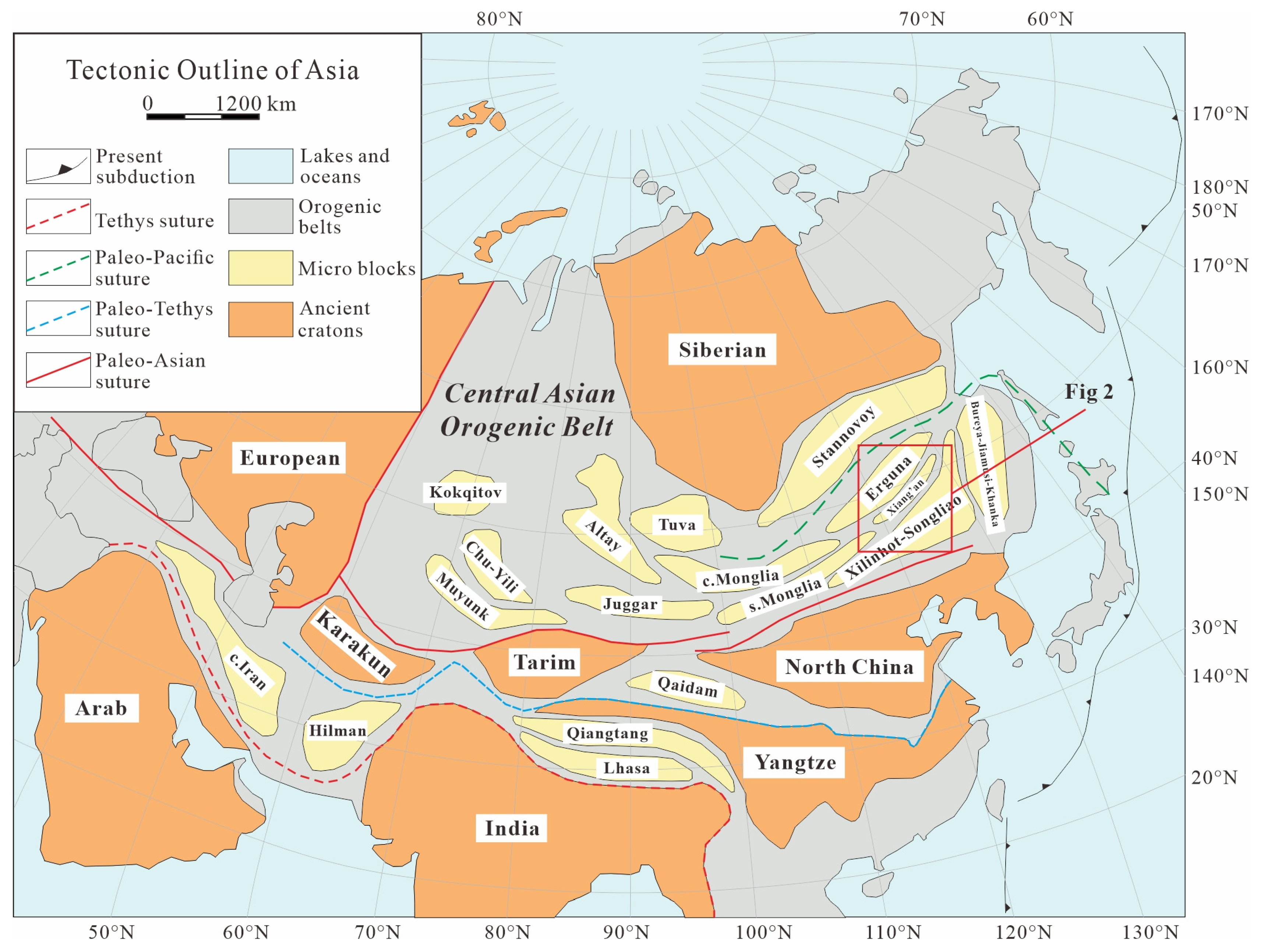
2. Geological Setting and Sample Descriptions
3. Analytical Methods
3.1. Zircon U–Pb Dating
3.2. Major and Trace Elements
4. Results
4.1. Zircon U–Pb Ages
4.1.1. Early Carboniferous Intrusive Rocks
4.1.2. Late Carboniferous Intrusive Rocks
4.2. Geochemistry
4.2.1. Major Element Compositions
4.2.2. Trace Element Compositions
5. Discussion
5.1. Carboniferous Intrusive Rocks in the Great Xing’an Range
5.2. Petrogenesis of Carboniferous Intrusive Rocks in the Northern Great Xing’an Range
5.2.1. Petrogenesis of the Wunuer Early Carboniferous Igneous Rocks
5.2.2. Petrogenesis of the Wunuer Late Carboniferous Igneous Rocks
5.3. Inferred Tectonic Settings
5.4. Tectonic Implications
6. Conclusions
Supplementary Materials
Author Contributions
Funding
Data Availability Statement
Acknowledgments
Conflicts of Interest
References
- Jahn, B.M.; Wu, F.Y.; Chen, B. Granitoids of the Central Asian Orogenic Belt and continental growth in the Phanerozoic. Trans. R. Soc. Edinb. 2000, 91, 181–194. [Google Scholar]
- Jahn, B.M.; Wu, F.Y.; Chen, B. Massive granitoid generation in Central Asia: Nd isotope evidence and implication for continental growth in the Phanerozoic. Episodes 2000, 23, 82–92. [Google Scholar] [CrossRef] [PubMed]
- Kröner, A.; Windley, B.F.; Badarch, G. Accretionary growth and crust-formation in the Central Asian Orogenic Belt and comparison with the Arabian–Nubian shield. Geol. Soc. Am. Mem. 2007, 200, 181–209. [Google Scholar]
- Kröner, A.; Kovach, V.; Belousova, E.; Hegner, E.; Armstrong, R.; Dolgopolova, A.; Seltmann, R.; Alexeiev, D.V.; Hoffmann, J.E.; Wong, J. Reassessment of continental growt during the accretionary history of the Central Asian Orogenic Belt. Gondwana Res. 2014, 25, 103–125. [Google Scholar] [CrossRef]
- Liu, Y.J.; Feng, Z.Q.; Jiang, L.W.; Jin, W.; Li, W.M.; Guan, Q.B.; Wen, Q.B.; Liang, C.Y. Ophiolite in the eastern Central Asian Orogenic Belt, NE China. Acta Petrol. Sin. 2019, 35, 3017–3047, (In Chinese with English Abstract). [Google Scholar]
- Liu, Y.J.; Li, W.M.; Feng, Z.Q.; Wen, Q.B.; Neubauer, F.; Liang, C.Y. A review of the Paleozoic tectonics in the eastern part of Central Asian Orogenic Belt. Gondwana Res. 2017, 43, 123–148. [Google Scholar] [CrossRef]
- Liu, Y.J.; Li, W.M.; Ma, Y.F.; Feng, Z.Q.; Guan, Q.B.; Li, S.Z.; Chen, Z.X.; Liang, C.Y.; Wen, Q.B. An orocline in the eastern Central Asian Orogenic Belt. Earth-Sci. Rev. 2021, 221, 103808. [Google Scholar] [CrossRef]
- Liu, Y.J.; Ma, Y.F.; Feng, Z.Q.; Li, W.M.; Li, S.Z.; Guan, Q.B.; Chen, Z.X.; Zhou, T.; Fang, Q.A. Paleozoic Orocline in the eastern Central Asian Orogenic Belt. Acta Geol. Sin. 2022, 96, 3468–3493, (In Chinese with English Abstract). [Google Scholar]
- Safonova, I.Y.; Kotlyarov, A.; Krivonogov, S.; Xiao, W.J. Intra-oceanic arcs of the PaleoAsian Ocean. Gondwana Res. 2011, 50, 167–194. [Google Scholar] [CrossRef]
- Safonova, I.; Maruyama, S. Asia: A frontier for a future supercontinent Amasia. Int. Geol. Rev. 2014, 56, 1051–1071. [Google Scholar] [CrossRef]
- Yarmolyuk, V.V.; Kovach, V.P.; Kozakov, I.K. Mechanisms of continental crust formation in the Central Asian Foldbelt. Geotectonics 2012, 46, 251–272. [Google Scholar] [CrossRef]
- Xiao, W.J.; Windley, B.F.; Allen, M.B.; Han, C.M. Paleozoic multiple accretionary and collisional tectonics of the Chinese Tianshan orogenic collage. Gondwana Res. 2013, 23, 1316–1341. [Google Scholar] [CrossRef]
- Xiao, W.J.; Santosh, M. The western Central Asian Orogenic Belt: A window to accretionary orogenesis and continental growth. Gondwana Res. 2014, 25, 1429–1444. [Google Scholar] [CrossRef]
- Kovalenko, V.I.; Yarmolyuk, V.V.; Kovach, V.P.; Kotov, A.B.; Kozakov, I.K.; Salnikova, E.B.; Larin, A.M. Isotope provinces, mechanisms of generation and sources of the continental crust in the Central Asian mobile belt: Geological and isotopic evidence. J. Asian Earth Sci. 2004, 23, 605–627. [Google Scholar] [CrossRef]
- Safonova, I.Y.; Santosh, M. Accretionary complexes in the Asia–Pacific region: Tracing archives of ocean plate stratigraphy and tracking mantle plumes. Gondwana Res. 2014, 25, 126–158. [Google Scholar] [CrossRef]
- Dobretsov, N.L.; Berzin, N.A.; Buslov, M.M. Opening and tectonic evolution of the Paleo-Asian Ocean. Int. Geol. Rev. 1995, 37, 335–360. [Google Scholar] [CrossRef]
- Xiao, W.J.; Windley, B.F.; Hao, J.; Zhai, M.G. Accretion leading to collision and the Permian Solonker suture, Inner Mongolia, China: Termination of the central Asian orogenic belt. Tectonic 2003, 22, 8.1–8.20. [Google Scholar] [CrossRef]
- Windley, B.F.; Alexeiev, D.; Xiao, W.J.; Kröner, A.; Badarch, G. Tectonic models for accretion of the Central Asian Orogenic Belt. J. Geol. Soc. 2007, 164, 31–47. [Google Scholar] [CrossRef]
- Safonova, I.Y.; Sennikov, N.V.; Komiya, T. Geochemical diversity in oceanic basalts hosted by the Zasur’ya accretionary complex, NW Russian Altai, Central Asia: Implications from trace elements and Nd isotopes. J. Asian Earth Sci. 2011, 42, 191–207. [Google Scholar] [CrossRef]
- Safonova, I.Y. Juvenile versus recycled crust in the Central Asian Orogenic Belt: Implications from ocean plate stratigraphy, blueschist belts and intraoceanic arcs. Gondwana Res. 2017, 47, 6–27. [Google Scholar] [CrossRef]
- Li, J.Y. Permian geodynamic setting of Northeast China and adjacent regions: Closure of the Paleo-Asian Ocean and subduction of the Paleo-Pacific Plate. J. Asian Earth Sci. 2006, 26, 207–224. [Google Scholar] [CrossRef]
- Kröner, A.; Lehmann, J.; Schulmann, K.; Demoux, A.; Lexa, O.; Tomurhuu, D.; Stipska, P.; Liu, D.; Wingate, M.T.D. Lithostratigraphic and geochronological constraints on the evolution of the Central Asian Orogenic Belt in SW Mongolia: Early Paleozoic rifting followed by late Paleozoic accretion. Am. J. Sci. 2010, 310, 523–574. [Google Scholar] [CrossRef]
- Zheng, Y.F.; Xiao, W.J.; Zhao, G.C. Introduction to tectonic of China. Gondwana Res. 2013, 23, 1189–1206. [Google Scholar] [CrossRef]
- Ge, W.C.; Wu, F.Y.; Zhou, C.Y.; Abdel Rahman, A.A. Emplacement age of the Tahe granite and its constraints on the tectonic nature of the Erguna block in the northern part of the Da Xing’an Range. Chin. Sci. Bull. 2005, 50, 2097–2105, (In Chinese with English Abstract). [Google Scholar] [CrossRef]
- Miao, L.C.; Fan, W.M.; Zhang, F.Q.; Liu, D.Y.; Jian, P.; Shi, G.H.; Tao, H.; Shi, Y.R. Zircon SHRIMP geochronology of the Xinkailing-Kele complex in the northwestern Lesser Xing’an Range, and its geological implications. Chin. Sci. Bull. 2004, 49, 201–209, (In Chinese with English Abstract). [Google Scholar] [CrossRef]
- Miao, L.C.; Liu, D.Y.; Zhang, F.Q. Zircon SHRIMP U-Pb ages of the “Xinghuadukou Group” in Hanjiayuanzi and Xinlin areas and the “Zhalantun Group” in Inner Mongolia, Da Hinggan Mountains. Chin. Sci. Bull. 2007, 52, 1112–1134, (In Chinese with English Abstract). [Google Scholar] [CrossRef]
- Miao, L.C.; Zhang, F.C.; Jiao, S.J. Age, protoliths and tectonic implications of the Toudaoqiao blueschist Inner Mongolia, China. J. Asian Earth Sci. 2015, 105, 360–373. [Google Scholar] [CrossRef]
- Wu, F.Y.; Sun, D.Y.; Ge, W.C.; Zhang, Y.B.; Grant, M.L.; Wilde, S.A.; Jahn, B.M. Geochronology of the Phanerozoic granitoids in northeastern China. J. Asian Earth Sci. 2011, 41, 1–30. [Google Scholar] [CrossRef]
- Xu, W.L.; Wang, F.; Pei, F.P.; Meng, E.; Tang, J.; Xu, M.J.; Wang, W. Mesozoic tectonic regimes and regional ore-forming background in NE China: Constraints from spatial and temporal variations of Mesozoic volcanic rock associations. Acta Petrol. Sin. 2013, 29, 339–353, (In Chinese with English Abstract). [Google Scholar]
- Liu, Y.J.; Zhang, X.Z.; Jin, W.; Chi, X.G.; Wang, C.W.; Ma, Z.H.; Han, G.Q.; Wen, Q.B.; Li, W.; Wang, W.D.; et al. Late Paleozoic tectonic evolution in Northeast China. Geol. China 2010, 37, 943–951, (In Chinese with English Abstract). [Google Scholar]
- Zhou, J.B.; Wilde, S.A.; Zhang, X.Z.; Zhao, G.C.; Liu, F.L.; Qiao, D.W.; Ren, S.M.; Liu, J.H. A N1300 km late Pan-African metamorphic belt in NE China: New evidence from the Xing’an block and its tectonic implications. Tectonophysics 2011, 509, 280–292. [Google Scholar] [CrossRef]
- Zhou, J.B.; Wilde, S.A.; Zhang, X.Z.; Ren, S.M.; Zheng, C.Q. Early Paleozoic metamorphic rocks of the Erguna block in the Great Xing’an Range, NE China: Evidence for the timing of magmatic and metamorphic events and their tectonic implications. Tectonophysics 2011, 499, 105–117. [Google Scholar] [CrossRef]
- Zhou, J.B.; Wang, B.; Wilde, S.i.m.o.n.A.; Zhao, G.C.; Cao, J.L.; Zheng, C.Q.; Zeng, W.S. Geochemistr-y and U-Pb zircon dating of the Toudaoqiao blueschists in the Great Xing’an Range, Northeast China, and tectonic implications. J. Earth Sci. 2015, 97, 197–210. [Google Scholar]
- Zhou, J.B.; Wilde, S.A. The crustal accretion history and tectonic evolution of the NE China segment of the Central Asian Orogenic Belt. Gondwana Res. 2013, 23, 1365–1377. [Google Scholar] [CrossRef]
- Han, G.Q.; Liu, Y.J.; Neubauer, F.; Genser, J.; Li, W.; Zhao, Y.L.; Liang, C.Y. Origin of terranes in the eastern Central Asian Orogenic Belt, NE China: U-Pb ages of detrital zircons from Ordovician-Devonian sandstones, North Great Xing’an Range. Tectonophysics 2011, 511, 109–124. [Google Scholar] [CrossRef]
- Han, G.Q.; Liu, Y.J.; Neubauer, F.; Genser, J.; Zhao, Y.L.; Wen, Q.B.; Li, W.; Wu, L.N.; Jiang, X.Y.; Zhao, L.M. Provenance analysis of Permian sandstones in the central and southern Da Xing’an Mountains, China: Constraints on the evolution of the eastern segment of the Central Asian Orogenic Belt. Tectonophysics 2012, 580, 100–113. [Google Scholar] [CrossRef]
- Han, G.Q.; Liu, Y.J.; Neubauer, F.; Jin, W.; Genser, J.; Ren, S.M.; Li, W.; Wen, Q.B.; Zhao, Y.L.; Liang, C.Y. LA-ICP-MS U-Pb dating and Hf isotopic compositions of detrital zircons from the Permian sandstones in Da Xing’an Mountains, NE China: New evidence for the eastern extension of the Erenhot-Hegenshan suture zone. J. Asian Earth Sci. 2012, 49, 249–271. [Google Scholar] [CrossRef]
- Han, G.Q.; Liu, Y.J.; Neubauer, F.; Bartel, E.; Genser, J.; Feng, Z.Q.; Zhang, L.; Yang, M.C. U-Pb age and Hf isotopic data of detrital zircons from the Devonian and Carboniferous sandstones in Yimin area, NE China: New evidences to the collision timing between the Xing’an and Erguna blocks in eastern segment of Central Asian Orogenic Belt. J. Asian Earth Sci. 2015, 97, 211–228. [Google Scholar] [CrossRef]
- Xu, B.; Zhao, P.; Bao, Q.Z.; Zhou, Y.H.; Wang, Y.Y.; Luo, Z.W. Preliminary study on the pre-Mesozoic tectonic unit division of the Xing-Meng Orogenic Belt (XMOB). Acta Petrol. Sin. 2014, 30, 1841–1857, (In Chinese with English Abstract). [Google Scholar]
- Xu, B.; Zhao, P.; Wang, Y.Y.; Liao, W.; Luo, Z.W.; Bao, Q.Z.; Zhou, Y.H. The pre-Devonian tectonic framework of Xing’an-Mongolia Orogenic belt (XMOB) in north China. J. Asian Earth Sci. 2015, 97, 183–196. [Google Scholar] [CrossRef]
- Ma, Y.F.; Liu, Y.J.; Peskov, A.Y.; Wang, Y.; Song, W.M.; Zhang, Y.J.; Qian, C.; Liu, T.J. Paleozoic tectonic evolution of the eastern Central Asian Orogenic Belt in NE China. China Geol. 2022, 5, 555–578. [Google Scholar] [CrossRef]
- Li, J.Y.; Liu, J.F.; Qu, J.F.; Zheng, R.G.; Zhao, S.; Zhang, J.; Wang, L.J.; Zhang, X.W. Paleozoic tectonic units of Northeast China: Continental Blocks or Orogenic Belts? Earth Sci. 2019, 44, 3157–3177, (In Chinese with English Abstract). [Google Scholar]
- Li, R.S. Xinlin Ophiolite. Heilongjiang Geol. 1991, 2, 19–32, (In Chinese with English abstract). [Google Scholar]
- Ye, H.W.; Zhang, X.Z.; Zhou, Y.W. The texture and evolution of Manzhouli—Suifenhe lithosphere-study based on features of blueschist and ophiolites. In Geological Studies of Lithospheric Structure andEvolution of Manzhouli-Suifenhe Geotransect, China; MSGT Geology Group, Ed.; Seismological Press: Beijing, China, 1994; pp. 73–83, (In Chinese with English Abstract). [Google Scholar]
- Hu, D.G.; Tan, C.X.; Zhang, H. Middle Proterozoic Ophiolites in the Alihe area. Inner Mongolia. Reg. Geol. China 1995, 4, 334–339, (In Chinese with English Abstract). [Google Scholar]
- Hu, D.G.; Zheng, Q.D.; Fu, J.Y.; Liu, X.G. The geological and geochemical characteristics of the Jifeng Komatiites in the Da Hinggan Ling Mountains. J. Geomech. 2001, 7, 111–115, (In Chinese with English Abstract). [Google Scholar]
- Hu, D.G.; Li, H.W.; Liu, X.G.; Yu, R.W. Dating of Sm-Nd isochron Ages of the Jifeng Komatiites from the Da Xing’an Ling. Acta Geosci. Sin. 2003, 24, 405–408, (In Chinese with English Abstract). [Google Scholar]
- Zhu, K.Y.; Yang, J.X. The remains and history of evolution of the plate tectonics in the Geosynclinal region in the northern part of Inner Mongolia. Reg. Geol. China 1991, 4, 335–341, (In Chinese with English Abstract). [Google Scholar]
- Zhong, H.; Fu, J.Y. Petrochemistry, geochemistry and genesis of the metagabbro in Tayuan, Northern Daxing’anling. Geol. Resour. 2006, 15, 42–47, (In Chinese with English Abstract). [Google Scholar]
- Feng, Z.Q.; Liu, Y.J.; Liu, B.Q.; Wen, B.Q.; Li, W.M.; Liu, Q. Timing and nature of the Xinlin–Xiguitu Ocean: Constraints from ophiolitic gabbros in the northern Great Xing’an Range, eastern Central Asian Orogenic Belt. Int. J. Earth Sci. 2016, 105, 491–505. [Google Scholar] [CrossRef]
- Du, B.Y.; Feng, Z.Q.; Liu, Y.W.; Zhang, T.A.; Zhao, M.S.; Zhao, Y.S.; Zhen, M. Determination of Neoproterozoic meta-gabbro from Huanerku, Da Hinggan Mountains and its geological significance. Glob. Geol. 2017, 36, 751–762, (In Chinese with English Abstract). [Google Scholar]
- She, H.Q.; Li, J.W.; Xiang, A.P.; Guan, J.D.; Zhang, D.Q.; Yang, Y.C.; Tan, G.; Zhang, B. U–Pb ages of the zircons from primary rocks in the middle–northern Daxinganling and its implications to geotectonic evolution. Acta Petrol. Sin. 2012, 28, 571–594, (In Chinese with English Abstract). [Google Scholar]
- Shi, Z.W.; Bai, Z.D.; Dong, G.C.; Santosh, M.; Li, L.Y.; Luo, Z.B.; Liu, T.; Wang, K.Q. Supra-subduction zone ophiolite from the Great Xing’an Range, China: Geochemistry, geochronology, and implication for formation in a back-arc setting. Geol. J. 2021, 57, 1783–1802. [Google Scholar] [CrossRef]
- Wu, G.; Chen, Y.C.; Sun, F.Y.; Liu, J.; Wang, G.R.; Xu, B. Geochronology, geochemistry, and Sr–Nd–Hf isotopes of the early Paleozoic igneous rocks in the Duobaoshan area, NE China, and their geological significance. J. Asian Earth Sci. 2015, 97, 229–250. [Google Scholar] [CrossRef]
- Zhao, C.; Qin, K.Z.; Song, G.X.; Li, G.M.; Li, Z.Z. Early Palaeozoic high-Mg basalt-andesite suite in the Duobaoshan Porphyry Cu deposit, NE China: Constraints on petrogenesis, mineralization, and tectonic setting. Gondwana Res. 2019, 71, 91–116. [Google Scholar] [CrossRef]
- Chen, A.X.; Zhou, D.; Zhang, Q.K.; Guan, P.Y.; Yang, B. Tectonic and sedimentary environment in the Ordovician period of Central Xing’an Block. Geoscience 2016, 30, 1061–1071, (In Chinese with English Abstract). [Google Scholar]
- Li, L.Y.; Liu, B. Sedimentary geological characteristics and sediment source of Luohe Formation in Wunuer Area, Great Xing’an Range. Mod. Min. 2020, 617, 37–45, (In Chinese with English Abstract). [Google Scholar]
- Zhang, H.H.; Xu, D.B.; Zhang, K. Geochemical characteristic and sedimentary environment of the Devonian Niqiuhe Formation in northern Daxinganling Range. Geol. Resour. 2014, 23, 316–322, (In Chinese with English Abstract). [Google Scholar]
- Zhang, Y.J.; Zhang, C.; Wu, X.W.; Cui, T.R.; Yang, Y.J.; Chen, H.J.; Jiang, B.; Guo, W.; Ma, Y.F. Geochronology and geochemistry of Late Paleozoic marine volcanic from the Zhalantun Area in Northern DaHinggan Mountains and its geological significance. Acta Geol. Sin. 2016, 90, 2706–2720, (In Chinese with English Abstract). [Google Scholar]
- Zhao, Z.; Chi, X.G.; Pan, S.Y.; Liu, J.F.; Sun, W.; Hu, Z.C. Zircon U-Pb LA-ICP-MS dating of Carboniferous volcanics and its geological significance in the northwestern Lasser Xing’an Range. Acta Petrol. Sin. 2010a, 26, 2452–2464, (In Chinese with English Abstract). [Google Scholar]
- Li, L.Y.; Chen, M.; Gong, Q.D.; Zhang, C.H.; Wang, X. Zircon U-Pb age, geochemical characteristics and geological significance of syenogranite in Wunuer area, Great Hinggan Mountains. Geol. Rev. 2019, 65, 389–400, (In Chinese with English Abstract). [Google Scholar]
- Ludwig, K.R. 2003.ISOPLOT 3.00: A Geochronological Toolkit for Microsoft Excel; Berkeley Geochronology Center: Berkeley, CA, USA.
- Middlemost, E.A.K. Naming materials in the magma/igneous rock system. Earth-Sci. Rev. 1994, 37, 215–224. [Google Scholar] [CrossRef]
- Maniar, P.D.; Piccoli, P.M. Tectonic discrimination of granitoids. Geol. Soc. Am. Bull. 1989, 101, 635–643. [Google Scholar] [CrossRef]
- Rickwood, P.C. Boundary lines within petrologic diagrams which use oxides of major and minor elements. Lithos 1989, 22, 247–263. [Google Scholar] [CrossRef]
- Zhao, Z.; Chi, X.G.; Liu, J.F.; Wang, T.F.; Hu, Z.C. Late Paleozoic arc-related magmatism in Yakeshi region, Inner Mongolia Chronological and geochemical evidence. Acta Petrol. Sin. 2010b, 26, 3245–3258, (In Chinese with English Abstract). [Google Scholar]
- Zhang, Y.; Pei, F.P.; Wang, Z.W.; Xu, W.L.; Li, Y.; Wang, F.; Zhou, Z.B. Late Paleozoic tectonic evolution of the central Great Xing’an Range, northeast China: Geochronological and geochemistry evidence from igneous rocks. Geol. J. 2018, 53, 282–303. [Google Scholar] [CrossRef]
- Jia, X.; Ren, J.G.; Xu, W.T.; Ma, H.C.; Zhang, C.; Shi, G.M. Zircon U-Pb dating of Late Paleozoic alkali-feldspar granite in Duobaoshan, Great Xing’an Range: Constrains on collision time of Xiang’an and Songnen Blocks. Geol. China 2022, 49, 586–600, (In Chinese with English Abstract). [Google Scholar]
- Shi, L.; Zheng, C.Q.; Yao, W.G.; Li, J.; Cui, F.H.; Cao, F.; Han, X.M. Geochronological framework and tectonic setting of the granitic magmatism in the Chaihe-Moguqi region, central Great Xing’an Range, China. J. Asian Earth Sci. 2015, 443–453. [Google Scholar] [CrossRef]
- Ma, Y.F.; Liu, Y.J.; Qin, T.; Sun, W.; Zang, Y.Q. Carboniferous granites in the Jalaid Banner area, middle Great Xing’an Range, NE China: Petrogenesis, tectonic background and orogeny accretionary implications. Acta Petrol. Sin. 2018, 34, 2931–2955, (in Chinese with English abstract). [Google Scholar]
- Ma, Y.F.; Liu, Y.J.; Qin, T.; Sun, W.; Zang, Y.Q.; Zhang, Y.J. Late Devonian to early Carboniferous magmatism in the western Songliao–Xilinhot block, NE China: Implications for eastward subduction of the Nenjiang oceanic lithosphere. Geol. J. 2020, 55, 2208–2231. [Google Scholar] [CrossRef]
- Ma, Y.F.; Liu, Y.J.; Wang, Y.; Qin, T.; Chen, H.J.; Sun, W.; Zang, Y.Q. Late Carboniferous mafic to felsic intrusive rocks in the central Great Xing’an Range, NE China: Petrogenesis and tectonic implications. Int. J. Earth Sci. 2020, 109, 761–783. [Google Scholar] [CrossRef]
- Feng, Z.Q.; Li, W.M.; Liu, Y.J.; Jin, W.; Wen, Q.B.; Liu, B.Q.; Zhou, J.P.; Zhang, T.A.; Li, X.Y. Early Carboniferous tectonic evolution of the northern Heihe–Nenjiang–Hegenshan suture zone, NE China: Constraints from the mylonitized Nenjiang rhyolites and the Moguqi gabbros. Geol. J. 2018, 53, 1005–1021. [Google Scholar] [CrossRef]
- Abdel-Karim, A.-A.M.; Azer, M.K.; Mogahed, M.M. Neoproterozoic concentric intrusive complex of gabbro-diorite-tonalite-granodiorite association, Rahaba area, southern Eastern Desert of Egypt: Implications for magma mixing of arc intrusive rocks. Lithos 2021, 404–405, 106423. [Google Scholar] [CrossRef]
- Altherr, R.; Siebel, W. I-type plutonism in a continental back-arc setting: Miocene granitoids and monzonites from the Central Aegean Sea, Greece. Contrib. Miner. Pet. 2002, 143, 397–415. [Google Scholar] [CrossRef]
- Clemens, J.D.; Stevens, G.; Farina, F. The enigmatic sources of I-type granites: The peritectic connexion. Lithos 2011, 126, 174–181. [Google Scholar] [CrossRef]
- Mogahed, M.M.; Abdelfadil, K.M. Constraints of Mantle and Crustal Sources Interaction during Orogenesis of Pre-and Post-collision Granitoids from the Northern Arabian-Nubian Shield: A Case Study from Wadi El-Akhder Granitoids, Southern Sinai, Egypt. Acta Geol. Sin.-Engl. Ed. 2021, 95, 1527–1550. [Google Scholar] [CrossRef]
- Yu, Y.; Sun, M.; Long, X.; Li, P.; Zhao, G.; Kröner, A.; Broussolle, A.; Yang, J. Whole-rock Nd–Hf isotopic study of I-type and peraluminous granitic rocks from the Chinese Altai: Constraints on the nature of the lower crust and tectonic setting. Gondwana Res. 2017, 47, 131–141. [Google Scholar] [CrossRef]
- Zhao, X.F.; Zhou, M.F.; Li, J.W.; Wu, F.Y. Association of Neoproterozoic A-and I-type granites in South China: Implications for generation of A-type granites in a subduction-related environment. Chem. Geol. 2008, 257, 1–15. [Google Scholar] [CrossRef]
- Sun, S.S.; McDonough, W.F. Chemical and isotopic systematics of ocean basalts: Implications for mantle composition and processes. In Magmatism in Ocean Basins; Saunders, A.D., Norry, M.J., Eds.; Geological Society Special Publication: London, UK, 1989; Volume 42, pp. 313–345. [Google Scholar]
- Whalen, J.B.; Currie, K.L.; Chappell, B.W. A-Type granites: Geochemical characteristics, discrimination and petrogenesis. Contrib. Mineral. Petrol. 1987, 95, 407–419. [Google Scholar] [CrossRef]
- Chappell, B.; White, A.J.R. I- and S-type granites in the Lachlan Fold Belt. Trans. R. Soc. Edinb. Earth Sci. 1992, 83, 1–26. [Google Scholar]
- Pearce, J.A.; Harris, N.B.W.; Tindle, A.G. Trace element discrimination diagrams for the tectonic interpretation of granitic rocks. J. Petrol. 1984, 25, 956–983. [Google Scholar] [CrossRef]
- Harris, R.A.; Stone, D.B.; Turner, D.L. Tectonic implications of paleomagnetic and geochronologic data from the Yukon-Koyukuk province, Alaska. Geol. Soc. Am. Bull. 1987, 99, 362–375. [Google Scholar] [CrossRef]
- Grove, T.L.; Elkins-Tanton, L.T.; Parman, S.W.; Cartterjee, N.; Muntener, O.; Gaetani, G.A. Fractional crystallization and mantle melting controls on calk-alkaline differentiation trends. Contrib. Mineral. Petrol. 2003, 145, 515–533. [Google Scholar] [CrossRef]
- Tang, J.; Xu, W.L.; Wang, F.; Wang, W.; Xu, M.J.; Zhang, Y.H. Geochronology and geochemistry of Neoproterozoic magmatism in the Erguna Massif, NE China: Petrogenesis and implications for the breakup of the Rodinia supercontinent. Precambrian Res. 2013, 224, 597–611. [Google Scholar] [CrossRef]
- Tang, J.; Xu, W.L.; Wang, F.; Wang, W.; Xu, M.J.; Zhang, Y.H. Geochronology and geochemistry of Early-Middle Triassic magmatism in the Erguna Massif, NE China: Constraints on the tectonic evolution of the Mongol-Okhotsk Ocean. Lithos 2014, 184–187, 1–16. [Google Scholar] [CrossRef]
- Li, Y.; Xu, W.L.; Wang, F.; Tang, J.; Pei, F.P.; Wang, Z.J. Geochronology and geochemistry of late Paleozoic volcanic rocks on the western margin of the Songnen-Zhangguangcai Range Massif, NE China: Implications for the amalgamation history of the Xing’an and Songnen-Zhangguangcai Range massifs. Lithos 2014, 205, 394–410. [Google Scholar] [CrossRef]
- Zhu, X.Y.; Liu, G.P. Geochemical characteristics of Paleozoic margine volcanic rocks in Southern Hulun Buir League, Inner Mongolia, and their geological significance. Acta Petrol. Et Mineral. 1995, 14, 109–118, (In Chinese with English Abstract). [Google Scholar]
- Li, J.Y. Some new ideas on tectonics of NE China and its neighboring areas. Geol. Rev. 1998, 44, 339–347, (In Chinese with English Abstract). [Google Scholar]
- Stern, R.J. Subduction zones. Rev. Geophys. 2002, 40, 3-1–3-38. [Google Scholar] [CrossRef]
- Li, J.Y.; Zhang, J.; Yang, T.N.; Li, Y.P.; Sun, G.H.; Zhu, Z.X.; Wang, L.J. Crustal tectonic vivision and evolution of the southern part of the North Asian Orogenic Region and its adajacent Areas. J. Jilin Univ. (Earth Sci. Ed.) 2009, 39, 584–605, (In Chinese with English Abstract). [Google Scholar]
- Zhang, Y.L.; Ge, W.C.; Gao, Y.; Chen, J.S.; Zhao, L. Zircon U-Pb ages and Hf isotopes of granites in Longzhen area and their geological implication. Acta Petrol. Sin. 2010, 26, 1059–1073, (In Chinese with English Abstract). [Google Scholar] [CrossRef]
- Ren, X.H.; He, Z.H.; Wang, Q.H.; Zhou, X.M.; Zhao, D.; He, Y.; Ge, W.C. Pertogenesis of Late Paleozoic granites from Yaergenchu area in north-central Great Xing’an Range and its geological implication. Glob. Geol. 2017, 36, 41–53, (In Chinese with English Abstract). [Google Scholar]
- Zhou, C.Y.; Wu, F.Y.; Ge, W.C.; Sun, D.Y.; Abdel, R.A.; Zhang, J.H.; Cheng, R.Y. Age, geochemistry and petrogenesis of the cumulate gabbro in Tahe, northern Da Hinggan Mountain. Acta Petrol. Sin. 2005, 21, 763–775, (In Chinese with English Abstract). [Google Scholar]
- Zhao, Q. The Genetic Type and Geological Significe of Late Paleozoic Granites in Yakeshi Region, North Great Xing’an Range. China. Master’s thesis, University of Geosciences, Beijing, China, 2012; pp. 1–83, (In Chinese with English Abstract). [Google Scholar]
- Sun, D.Y.; Wu, F.Y.; Li, H.M.; Lin, Q. Emplacement age of the post-orogenic A-type granites in Northwestern Lesser Xing’an Range, and its relationship to the eastward extension of Suolushan-Hegenshan-Zhalaite collisional suture zone. Chin. Sci. Bull. 2000, 45, 2217–2222, (In Chinese with English Abstract). [Google Scholar]
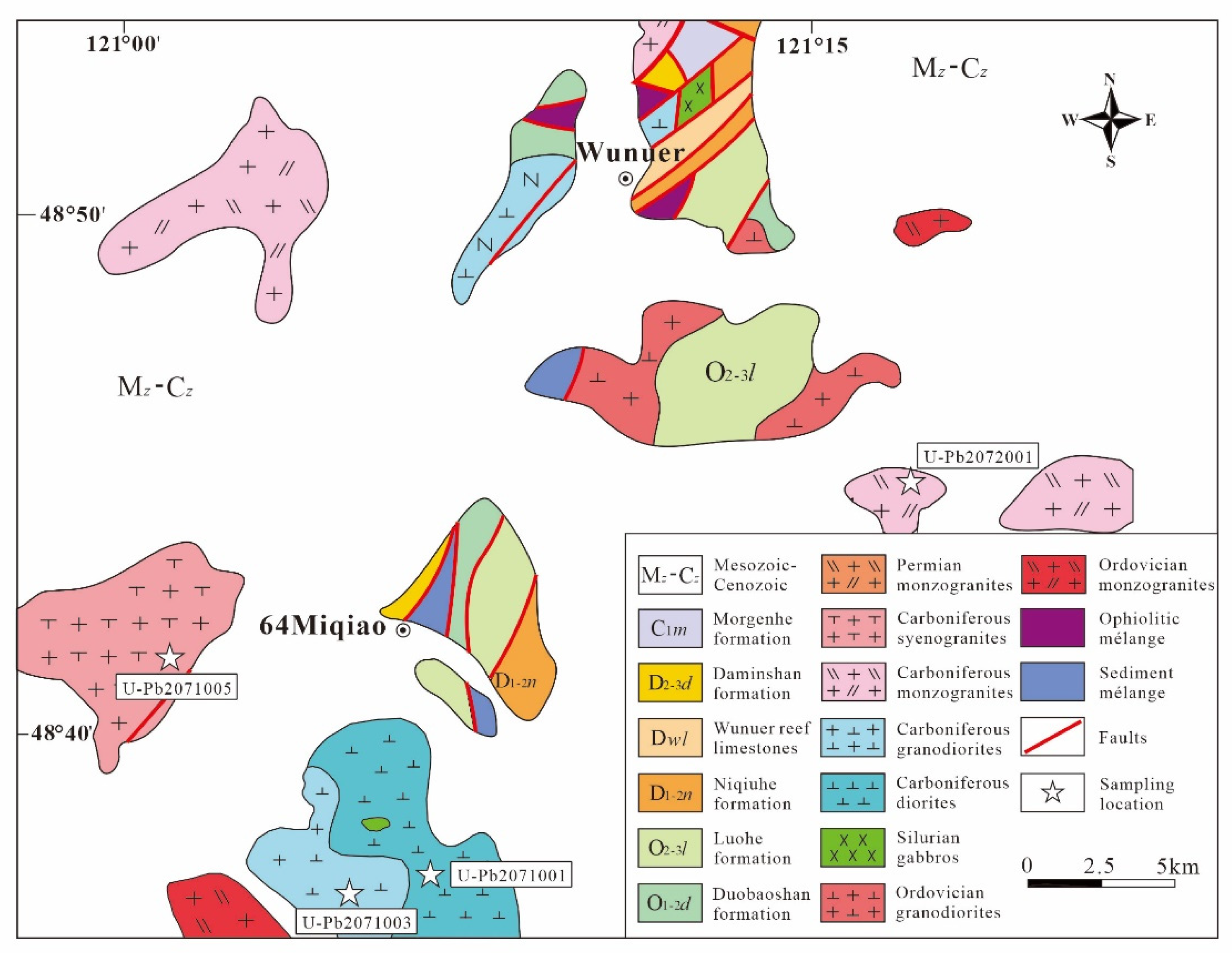

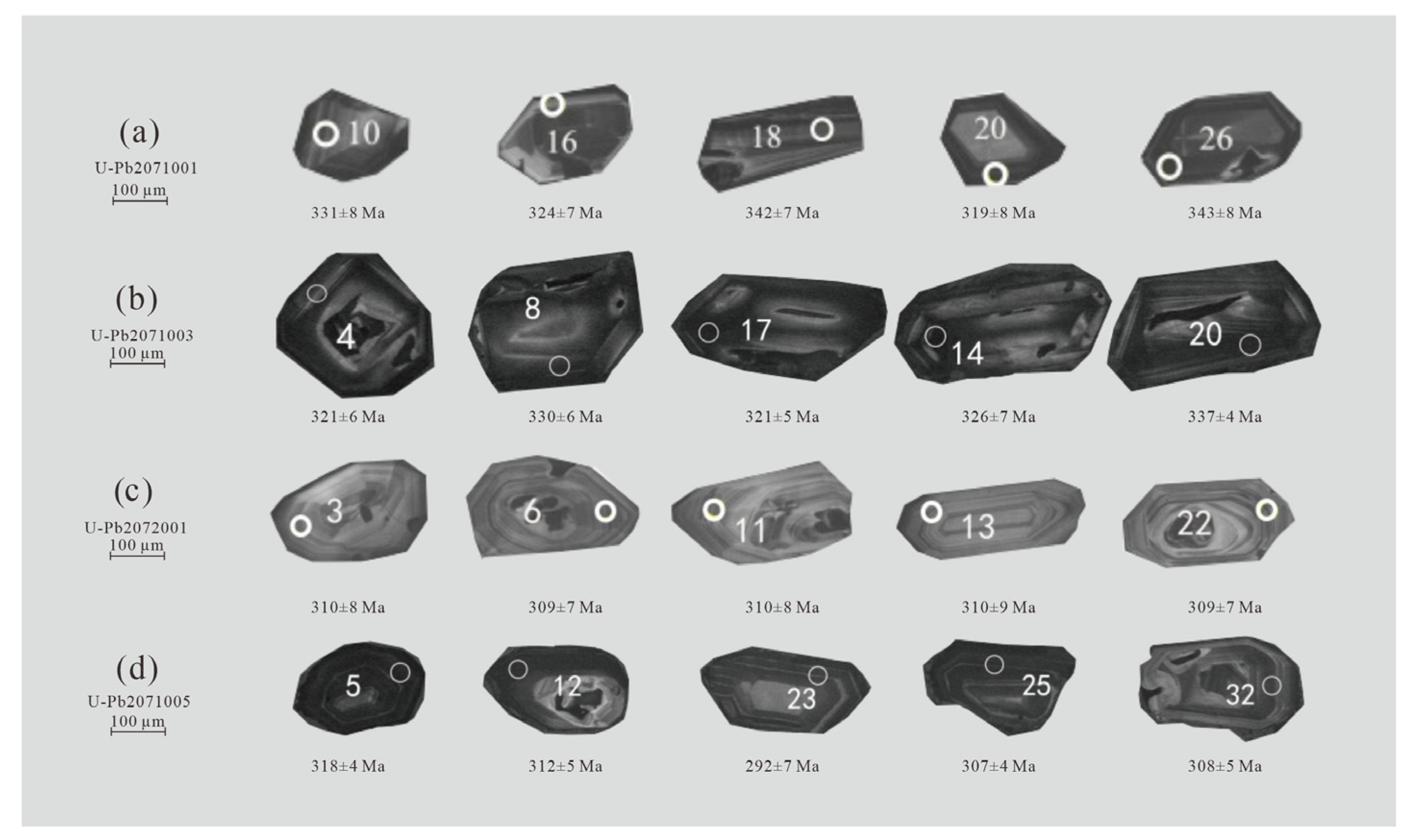
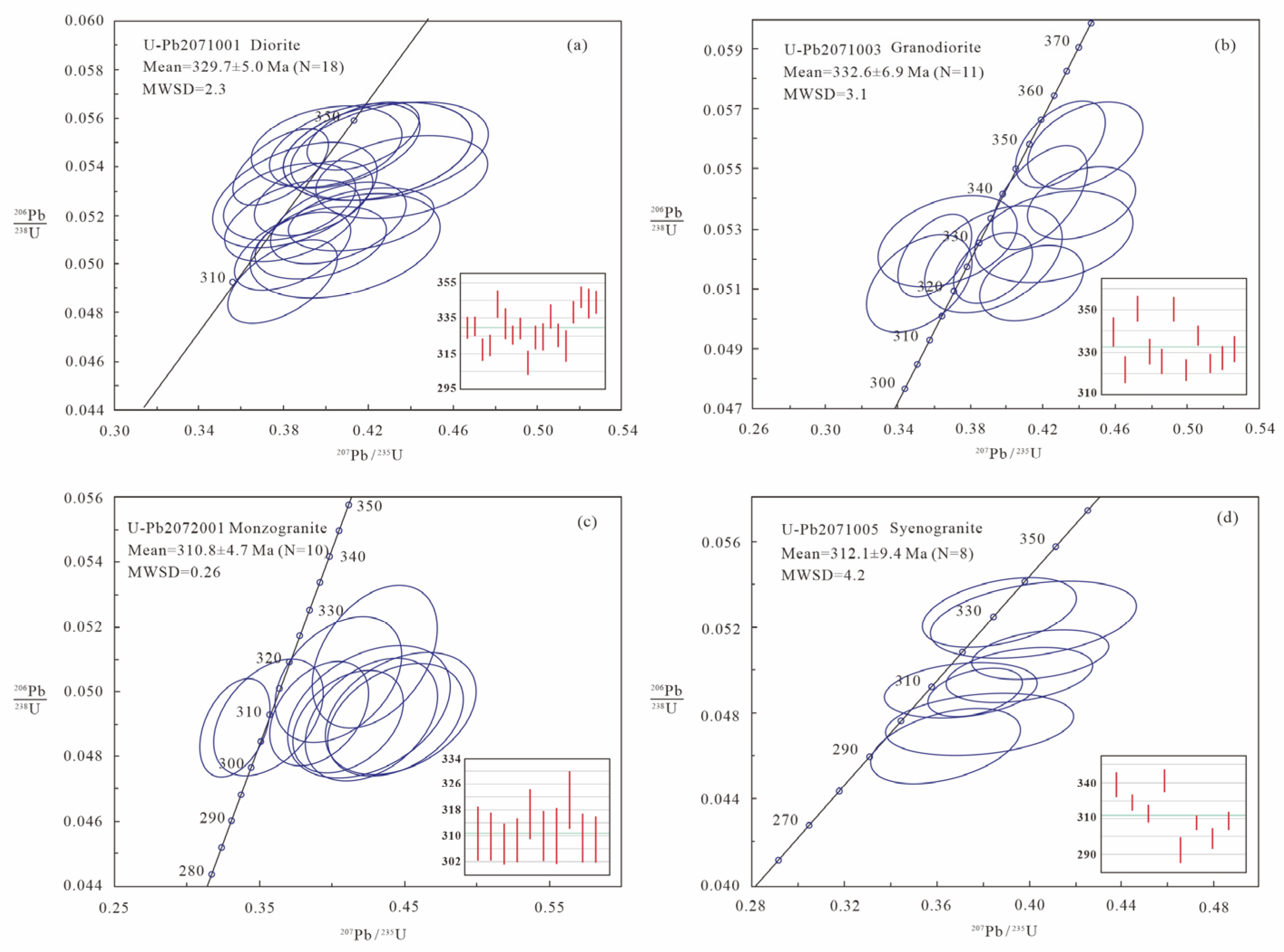

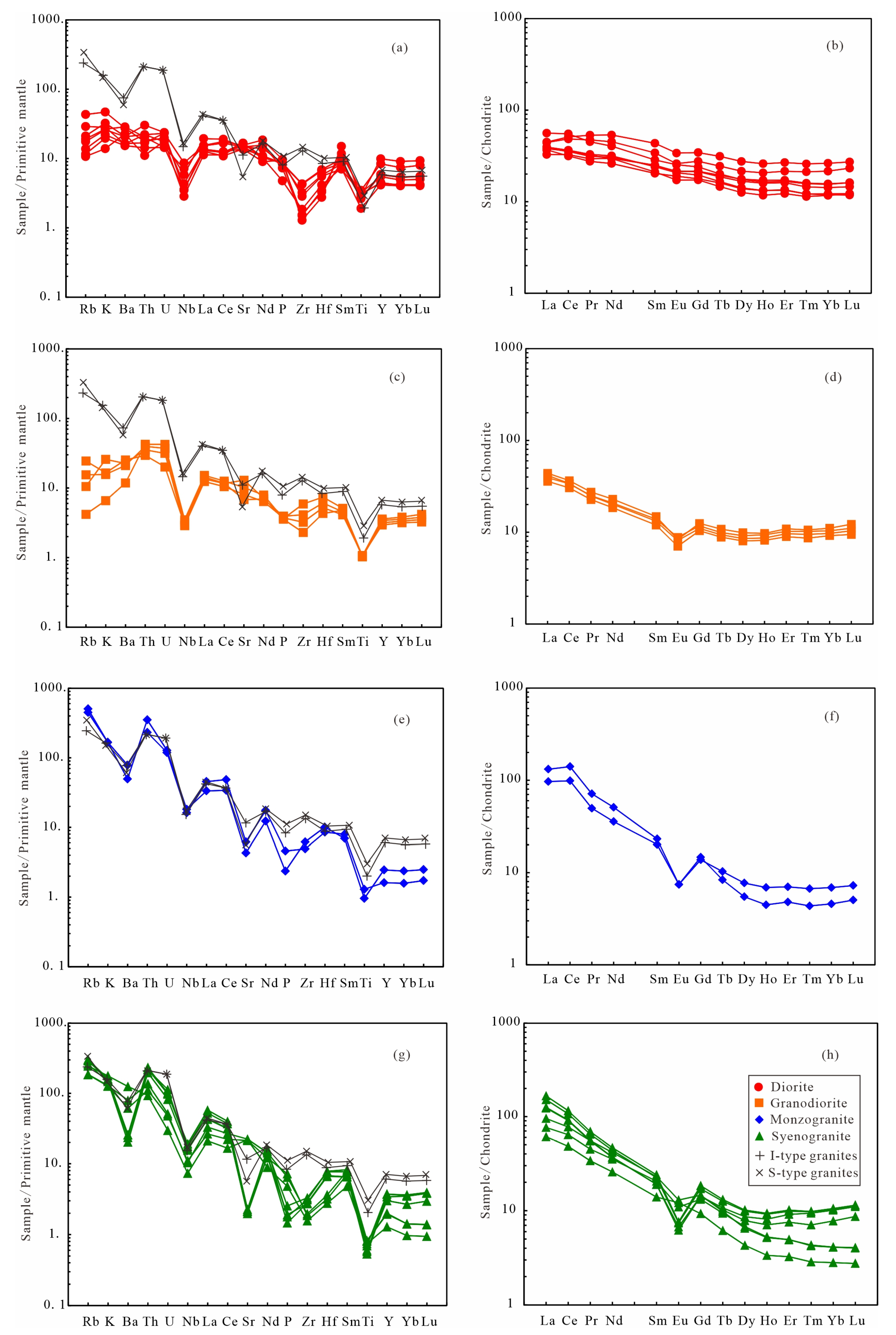
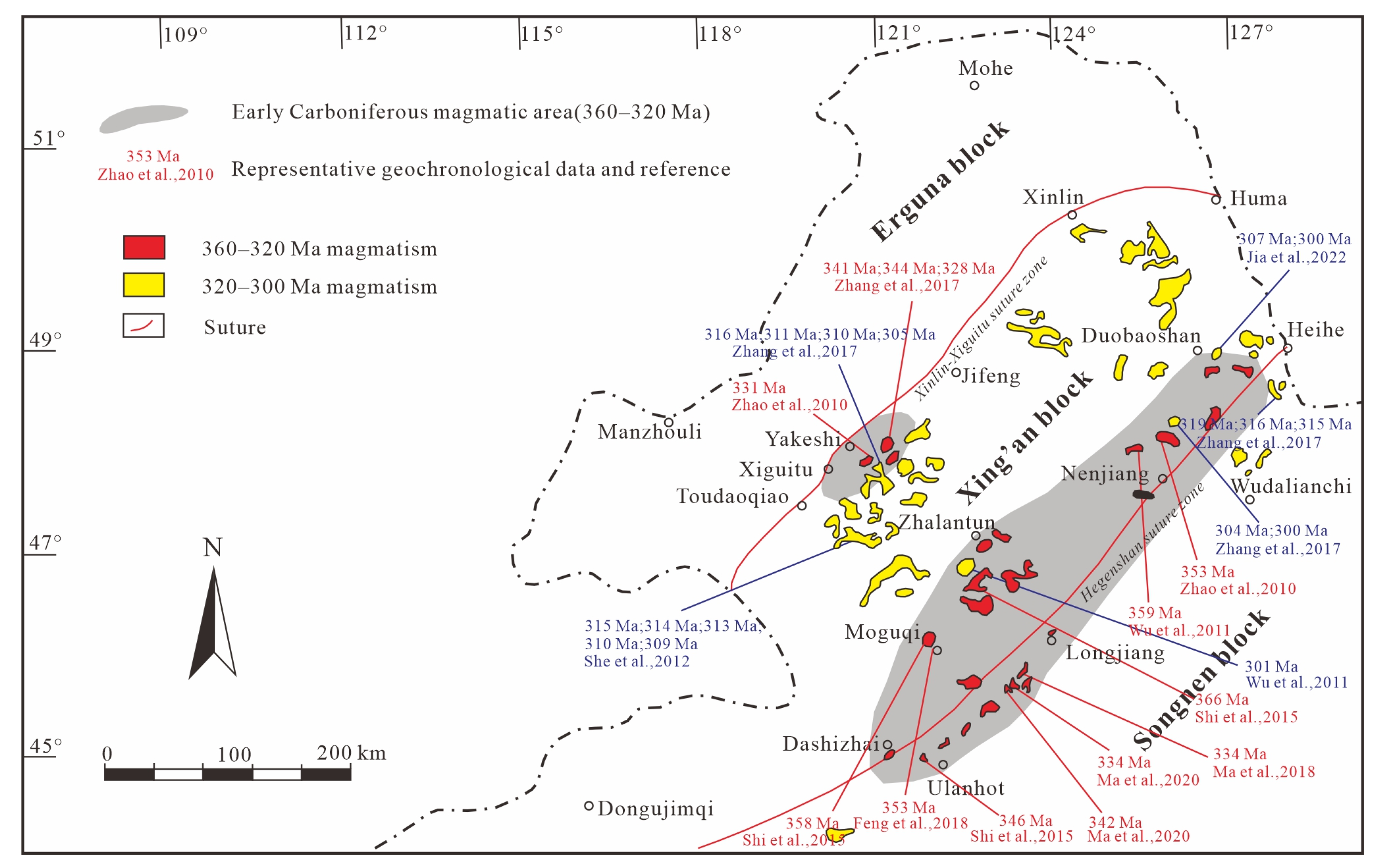
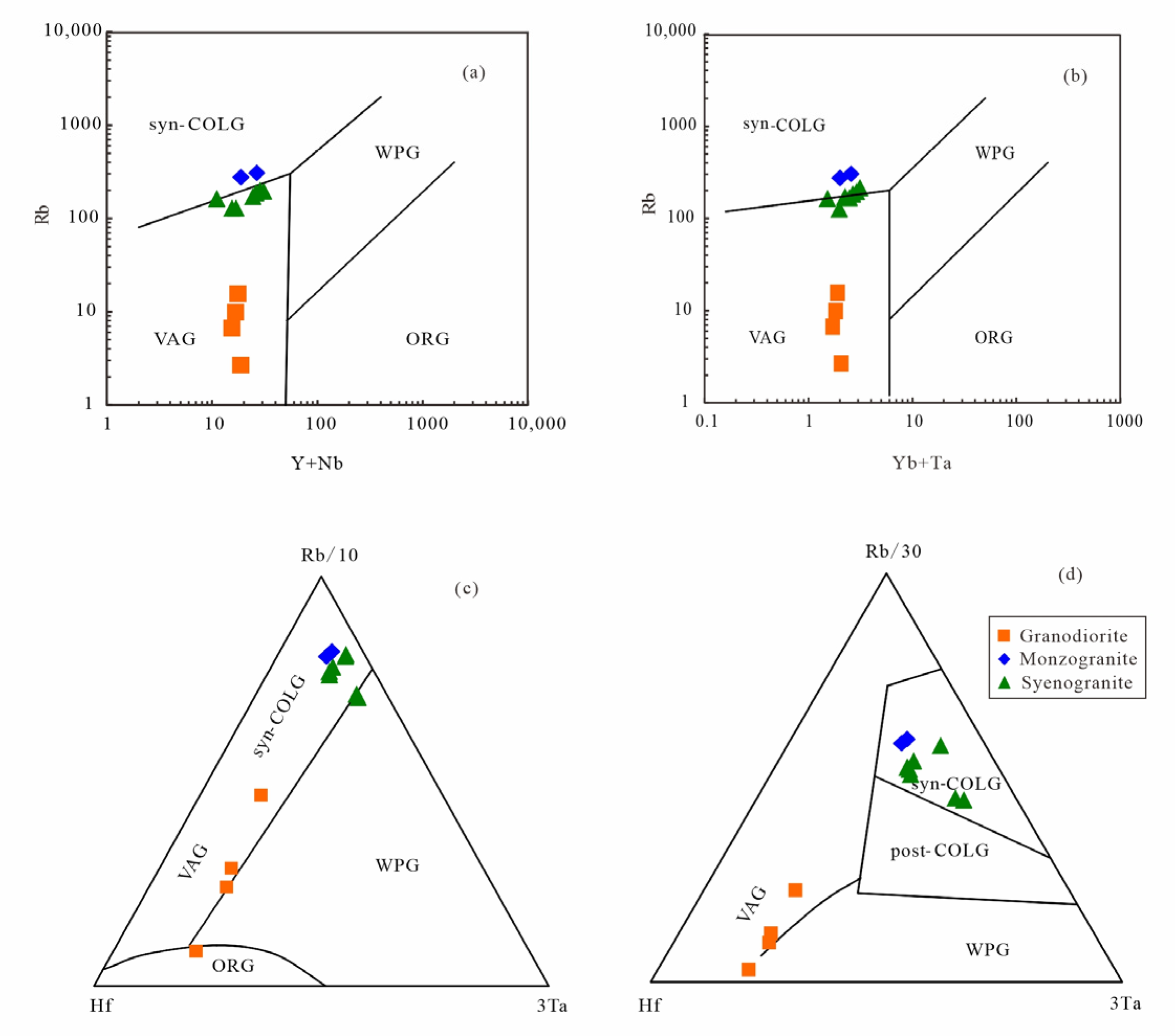
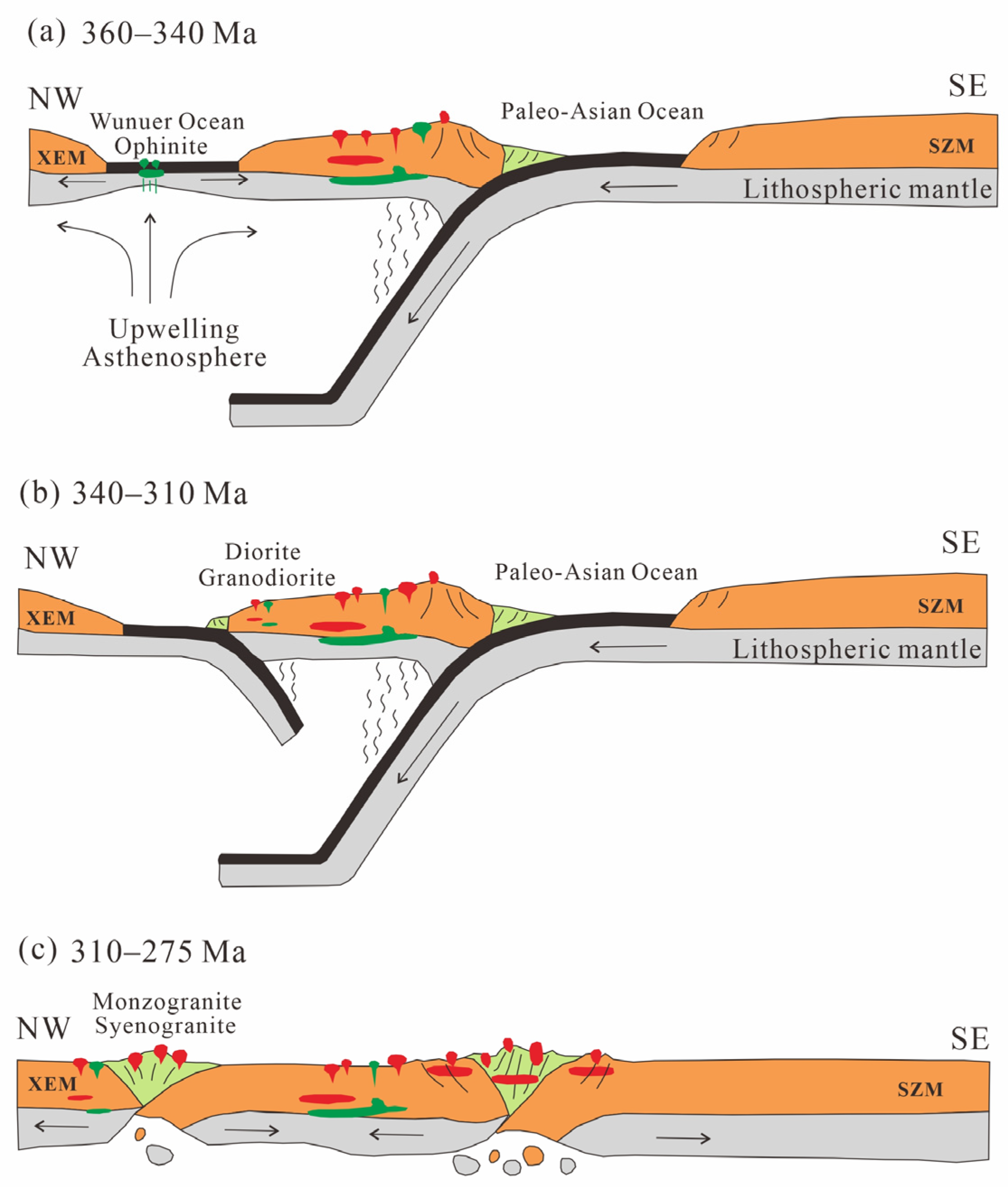
| Rocks | Diorite | Granodiorite | Monzogranite | Syenogranite | |||||||||||||||||
|---|---|---|---|---|---|---|---|---|---|---|---|---|---|---|---|---|---|---|---|---|---|
| Sample | 001 | 002 | 003 | 004 | 005 | 006 | 007 | 008 | 009 | 010 | 011 | 012 | 013 | 014 | 015 | 016 | 017 | 018 | 019 | 020 | 021 |
| Major oxides (wt%) | |||||||||||||||||||||
| SiO2 | 56.01 | 54.41 | 57.85 | 55.68 | 52.59 | 54.49 | 55.71 | 57.22 | 62.00 | 64.74 | 64.57 | 64.35 | 71.07 | 74.64 | 76.97 | 75.10 | 78.50 | 72.60 | 71.68 | 72.15 | 76.97 |
| TiO2 | 0.78 | 0.94 | 0.77 | 0.90 | 0.88 | 1.02 | 0.82 | 0.56 | 0.31 | 0.30 | 0.30 | 0.31 | 0.38 | 0.28 | 0.16 | 0.21 | 0.18 | 0.24 | 0.24 | 0.22 | 0.17 |
| Al2O3 | 16.35 | 16.43 | 17.11 | 16.00 | 16.28 | 16.58 | 16.41 | 15.87 | 13.77 | 12.86 | 12.81 | 12.23 | 14.21 | 13.30 | 12.41 | 13.33 | 11.65 | 14.68 | 15.28 | 15.57 | 12.51 |
| TFe2O3 | 7.76 | 9.12 | 8.23 | 8.88 | 9.57 | 9.73 | 8.63 | 7.54 | 6.53 | 5.93 | 6.19 | 6.59 | 3.17 | 1.56 | 0.82 | 0.91 | 0.70 | 1.48 | 1.43 | 0.98 | 0.72 |
| MgO | 0.18 | 0.16 | 0.13 | 0.15 | 0.16 | 0.14 | 0.15 | 0.13 | 0.12 | 0.11 | 0.10 | 0.12 | 0.04 | 0.04 | 0.05 | 0.04 | 0.02 | 0.04 | 0.03 | 0.02 | 0.04 |
| MnO | 5.13 | 5.12 | 3.54 | 4.69 | 5.96 | 4.39 | 4.44 | 4.26 | 5.18 | 4.65 | 5.02 | 5.31 | 0.62 | 0.32 | 0.14 | 0.25 | 0.18 | 0.53 | 0.53 | 0.37 | 0.15 |
| CaO | 7.84 | 6.40 | 6.58 | 5.82 | 7.44 | 7.78 | 7.53 | 8.68 | 6.37 | 5.29 | 5.13 | 5.75 | 0.33 | 0.26 | 0.43 | 0.65 | 0.42 | 1.00 | 1.39 | 1.09 | 0.42 |
| Na2O | 3.64 | 3.93 | 3.38 | 3.91 | 3.69 | 3.69 | 3.84 | 2.54 | 3.12 | 3.08 | 2.99 | 2.92 | 3.95 | 3.39 | 3.63 | 3.91 | 3.22 | 4.42 | 4.48 | 3.86 | 3.52 |
| K2O | 0.77 | 1.38 | 0.41 | 0.78 | 0.83 | 0.66 | 0.58 | 0.95 | 0.76 | 0.48 | 0.46 | 0.19 | 4.95 | 4.97 | 4.67 | 4.83 | 4.40 | 3.75 | 3.82 | 5.32 | 4.66 |
| P2O5 | 0.14 | 0.13 | 0.14 | 0.15 | 0.13 | 0.11 | 0.15 | 0.07 | 0.06 | 0.06 | 0.06 | 0.06 | 0.07 | 0.04 | 0.02 | 0.04 | 0.03 | 0.11 | 0.10 | 0.08 | 0.03 |
| LOI | 1.38 | 1.94 | 1.83 | 2.99 | 2.42 | 1.38 | 1.71 | 2.14 | 1.76 | 2.40 | 2.30 | 2.15 | 1.20 | 1.11 | 0.61 | 0.64 | 0.61 | 1.07 | 1.01 | 0.23 | 0.73 |
| Total | 99.48 | 99.44 | 99.54 | 99.45 | 99.35 | 99.48 | 99.56 | 99.56 | 99.52 | 99.43 | 99.46 | 99.47 | 99.90 | 99.85 | 99.91 | 99.91 | 99.91 | 99.92 | 99.99 | 99.90 | 99.91 |
| A/NK | 2.40 | 2.06 | 2.85 | 2.20 | 2.34 | 2.45 | 2.36 | 3.05 | 2.31 | 2.30 | 2.36 | 2.44 | 1.20 | 1.21 | 1.12 | 1.14 | 1.16 | 1.30 | 1.33 | 1.28 | 1.15 |
| A/CNK | 0.78 | 0.84 | 0.95 | 0.90 | 0.79 | 0.79 | 0.80 | 0.76 | 0.79 | 0.85 | 0.87 | 0.79 | 1.14 | 1.16 | 1.05 | 1.04 | 1.08 | 1.12 | 1.09 | 1.11 | 1.08 |
| Trace elements (ppm) | |||||||||||||||||||||
| Rb | 11.10 | 27.40 | 6.78 | 12.10 | 18.40 | 8.73 | 7.36 | 13.40 | 15.50 | 9.82 | 6.66 | 2.66 | 285.00 | 320.00 | 184.00 | 193.00 | 164.00 | 117.00 | 118.00 | 155.00 | 189.00 |
| Ba | 144.00 | 192.00 | 158.00 | 200.00 | 113.00 | 115.00 | 107.00 | 145.00 | 177.00 | 147.00 | 157.00 | 82.60 | 546.00 | 346.00 | 179.00 | 179.00 | 141.00 | 428.00 | 553.00 | 870.00 | 164.00 |
| Th | 1.88 | 1.49 | 0.94 | 1.73 | 1.87 | 1.43 | 1.21 | 2.57 | 2.50 | 3.37 | 3.00 | 3.61 | 19.60 | 29.80 | 18.40 | 19.80 | 16.70 | 9.40 | 11.60 | 7.90 | 18.60 |
| U | 0.37 | 0.42 | 0.38 | 0.30 | 0.49 | 0.49 | 0.30 | 0.50 | 0.42 | 0.78 | 0.66 | 0.89 | 2.49 | 2.68 | 2.37 | 2.11 | 1.72 | 0.10 | 1.07 | 0.62 | 2.04 |
| Ta | 0.33 | 0.26 | 0.15 | 0.22 | 0.21 | 0.45 | 0.35 | 0.23 | 0.15 | 0.18 | 0.16 | 0.19 | 1.26 | 1.40 | 1.09 | 1.16 | 0.10 | 1.30 | 1.28 | 0.97 | 1.23 |
| Nb | 4.18 | 3.08 | 2.03 | 2.50 | 2.54 | 6.15 | 5.08 | 2.51 | 2.10 | 2.32 | 2.05 | 2.49 | 11.50 | 12.90 | 11.70 | 12.60 | 11.10 | 7.83 | 7.39 | 5.23 | 13.60 |
| La | 13.30 | 9.06 | 7.75 | 8.71 | 8.94 | 10.50 | 10.60 | 9.37 | 9.27 | 9.85 | 8.49 | 10.40 | 31.20 | 22.90 | 29.20 | 35.90 | 29.70 | 18.10 | 22.60 | 14.40 | 39.40 |
| Ce | 33.70 | 21.70 | 20.00 | 19.30 | 22.30 | 29.60 | 31.20 | 22.30 | 20.60 | 20.80 | 18.60 | 22.30 | 86.00 | 60.30 | 55.50 | 65.40 | 56.20 | 39.10 | 47.30 | 29.40 | 70.60 |
| Sr | 307.00 | 351.00 | 351.00 | 288.00 | 290.00 | 310.00 | 327.00 | 314.00 | 273.00 | 144.00 | 170.00 | 214.00 | 130.00 | 90.80 | 45.50 | 47.90 | 41.80 | 449.00 | 468.00 | 460.00 | 44.50 |
| Nd | 18.90 | 14.30 | 13.90 | 12.20 | 14.80 | 21.10 | 25.00 | 13.80 | 9.71 | 9.40 | 8.63 | 10.70 | 23.70 | 16.60 | 17.20 | 20.40 | 17.20 | 16.40 | 19.30 | 12.00 | 21.70 |
| Zr | 48.30 | 47.50 | 17.30 | 31.90 | 36.10 | 16.80 | 14.40 | 20.70 | 25.70 | 46.10 | 36.10 | 65.90 | 55.20 | 69.10 | 31.20 | 36.90 | 30.60 | 20.80 | 22.00 | 17.50 | 34.90 |
| Hf | 2.13 | 2.07 | 1.01 | 1.71 | 1.78 | 1.07 | 0.85 | 1.28 | 1.33 | 1.88 | 1.61 | 2.28 | 2.63 | 3.10 | 2.10 | 2.38 | 2.04 | 0.99 | 1.12 | 0.86 | 2.42 |
| Sm | 4.37 | 3.78 | 3.83 | 3.12 | 3.68 | 5.22 | 6.65 | 3.23 | 2.12 | 2.02 | 1.83 | 2.27 | 3.53 | 3.08 | 2.90 | 3.42 | 2.90 | 3.14 | 3.51 | 2.13 | 3.66 |
| Y | 26.80 | 24.90 | 26.40 | 19.80 | 20.50 | 38.20 | 45.10 | 18.90 | 15.50 | 14.40 | 13.40 | 16.30 | 7.34 | 11.20 | 15.60 | 17.00 | 13.70 | 9.09 | 8.83 | 5.86 | 16.90 |
| Yb | 2.63 | 2.42 | 2.66 | 2.07 | 2.02 | 3.66 | 4.47 | 1.99 | 1.76 | 1.65 | 1.56 | 1.88 | 0.78 | 1.17 | 1.72 | 1.75 | 1.32 | 0.70 | 0.70 | 0.48 | 1.79 |
| Lu | 0.41 | 0.37 | 0.41 | 0.31 | 0.30 | 0.59 | 0.69 | 0.31 | 0.28 | 0.26 | 0.24 | 0.31 | 0.19 | 0.18 | 0.28 | 0.27 | 0.22 | 0.10 | 0.10 | 0.07 | 0.29 |
| La | 13.30 | 9.06 | 7.75 | 8.71 | 8.94 | 10.50 | 10.60 | 9.37 | 8.49 | 9.27 | 9.85 | 10.40 | 31.2 | 22.90 | 29.20 | 35.90 | 29.70 | 18.10 | 22.60 | 14.40 | 39.40 |
| Ce | 33.70 | 21.70 | 20.00 | 19.30 | 22.30 | 29.60 | 31.20 | 22.30 | 18.60 | 20.60 | 20.80 | 22.30 | 86.00 | 60.30 | 55.50 | 65.40 | 56.20 | 39.10 | 47.30 | 29.40 | 70.60 |
| Pr | 4.29 | 2.97 | 2.79 | 2.62 | 3.12 | 4.50 | 5.06 | 3.06 | 2.15 | 2.37 | 2.35 | 2.60 | 6.76 | 4.71 | 5.20 | 6.14 | 5.30 | 4.26 | 5.24 | 3.21 | 6.56 |
| Nd | 18.90 | 14.30 | 13.90 | 12.20 | 14.80 | 21.10 | 25.00 | 13.80 | 8.63 | 9.71 | 9.40 | 10.70 | 23.70 | 16.60 | 17.20 | 20.40 | 17.20 | 16.40 | 19.30 | 12.00 | 21.70 |
| Sm | 4.37 | 3.78 | 3.83 | 3.12 | 3.68 | 5.22 | 6.65 | 3.23 | 1.83 | 2.12 | 2.02 | 2.27 | 3.53 | 3.08 | 2.90 | 3.42 | 2.90 | 3.14 | 3.51 | 2.13 | 3.66 |
| Eu | 1.47 | 1.25 | 1.24 | 1.10 | 1.20 | 1.51 | 1.97 | 1.00 | 0.41 | 0.51 | 0.47 | 0.48 | 0.43 | 0.43 | 0.39 | 0.43 | 0.36 | 0.63 | 0.75 | 0.70 | 0.44 |
| Gd | 4.92 | 4.38 | 4.41 | 3.66 | 4.02 | 5.67 | 7.07 | 3.55 | 2.13 | 2.40 | 2.26 | 2.56 | 3.02 | 2.83 | 2.92 | 3.51 | 2.93 | 2.71 | 3.00 | 1.91 | 3.78 |
| Tb | 0.75 | 0.70 | 0.73 | 0.60 | 0.62 | 0.91 | 1.17 | 0.55 | 0.33 | 0.37 | 0.35 | 0.40 | 0.31 | 0.38 | 0.40 | 0.47 | 0.38 | 0.35 | 0.37 | 0.23 | 0.49 |
| Dy | 4.42 | 4.24 | 4.48 | 3.51 | 3.60 | 5.47 | 6.99 | 3.20 | 2.04 | 2.33 | 2.17 | 2.51 | 1.39 | 1.96 | 2.19 | 2.51 | 1.99 | 1.72 | 1.65 | 1.09 | 2.58 |
| Ho | 0.93 | 0.90 | 0.97 | 0.75 | 0.75 | 1.17 | 1.47 | 0.67 | 0.46 | 0.53 | 0.49 | 0.55 | 0.25 | 0.39 | 0.46 | 0.52 | 0.40 | 0.30 | 0.29 | 0.19 | 0.53 |
| Er | 2.76 | 2.67 | 2.84 | 2.21 | 2.23 | 3.56 | 4.43 | 2.03 | 1.48 | 1.69 | 1.59 | 1.80 | 0.80 | 1.16 | 1.51 | 1.63 | 1.25 | 0.81 | 0.82 | 0.54 | 1.68 |
| Tm | 0.40 | 0.37 | 0.41 | 0.31 | 0.31 | 0.54 | 0.66 | 0.29 | 0.22 | 0.26 | 0.24 | 0.27 | 0.11 | 0.17 | 0.24 | 0.25 | 0.18 | 0.11 | 0.11 | 0.07 | 0.25 |
| Yb | 2.63 | 2.42 | 2.66 | 2.07 | 2.02 | 3.66 | 4.47 | 1.99 | 1.56 | 1.76 | 1.65 | 1.88 | 0.78 | 1.17 | 1.72 | 1.75 | 1.32 | 0.70 | 0.70 | 0.48 | 1.79 |
| Lu | 0.41 | 0.37 | 0.41 | 0.31 | 0.30 | 0.59 | 0.69 | 0.31 | 0.24 | 0.28 | 0.26 | 0.31 | 0.13 | 0.18 | 0.28 | 0.29 | 0.22 | 0.10 | 0.10 | 0.07 | 0.29 |
| Y | 26.80 | 24.90 | 26.40 | 19.80 | 20.50 | 38.20 | 45.10 | 18.90 | 13.40 | 15.50 | 14.40 | 16.30 | 7.34 | 11.20 | 15.60 | 17.00 | 13.70 | 9.09 | 8.83 | 5.86 | 16.90 |
| ΣREE | 93.25 | 69.11 | 66.41 | 60.47 | 67.89 | 94.00 | 107.43 | 65.34 | 53.90 | 48.58 | 54.20 | 59.03 | 158.41 | 116.27 | 120.11 | 142.62 | 120.33 | 88.44 | 105.737 | 66.422 | 153.75 |
| LREE/HREE | 4.42 | 3.31 | 2.93 | 3.51 | 3.90 | 3.36 | 2.99 | 4.19 | 4.98 | 4.74 | 4.64 | 4.74 | 22.34 | 13.09 | 11.36 | 12.05 | 12.88 | 12.00 | 14.03 | 13.51 | 12.50 |
| δEu | 0.97 | 0.94 | 0.92 | 0.99 | 0.95 | 0.84 | 0.87 | 0.90 | 0.66 | 0.63 | 0.69 | 0.61 | 0.39 | 0.44 | 0.41 | 0.38 | 0.37 | 0.65 | 0.69 | 1.04 | 0.36 |
| δCe | 1.09 | 1.02 | 1.05 | 0.98 | 1.03 | 1.06 | 1.04 | 1.02 | 1.03 | 1.04 | 1.05 | 1.02 | 1.39 | 1.35 | 1.02 | 0.99 | 1.01 | 1.05 | 1.03 | 1.02 | 0.98 |
| LaN/YbN | 3.63 | 2.69 | 2.09 | 3.02 | 3.17 | 2.06 | 1.70 | 3.38 | 4.28 | 3.90 | 3.78 | 3.97 | 28.77 | 14.04 | 12.18 | 14.72 | 16.15 | 18.60 | 23.22 | 21.61 | 15.80 |
| LaN/SmN | 2.18 | 1.72 | 1.45 | 2.00 | 1.74 | 1.44 | 1.14 | 2.08 | 3.33 | 3.14 | 3.50 | 3.29 | 6.34 | 5.34 | 7.23 | 7.53 | 7.35 | 4.14 | 4.62 | 4.85 | 7.73 |
| GdN/YbN | 1.55 | 1.50 | 1.37 | 1.46 | 1.65 | 1.28 | 1.31 | 1.48 | 1.13 | 1.13 | 1.13 | 1.13 | 3.21 | 2.00 | 1.40 | 1.66 | 1.84 | 3.21 | 3.56 | 3.31 | 1.75 |
Disclaimer/Publisher’s Note: The statements, opinions and data contained in all publications are solely those of the individual author(s) and contributor(s) and not of MDPI and/or the editor(s). MDPI and/or the editor(s) disclaim responsibility for any injury to people or property resulting from any ideas, methods, instructions or products referred to in the content. |
© 2023 by the authors. Licensee MDPI, Basel, Switzerland. This article is an open access article distributed under the terms and conditions of the Creative Commons Attribution (CC BY) license (https://creativecommons.org/licenses/by/4.0/).
Share and Cite
Li, L.; Zhang, C.; Feng, Z. Late Paleozoic Tectonic Evolution of the Northern Great Xing’an Range, Northeast China: Constraints from Carboniferous Magmatic Rocks in the Wunuer Area. Minerals 2023, 13, 1090. https://doi.org/10.3390/min13081090
Li L, Zhang C, Feng Z. Late Paleozoic Tectonic Evolution of the Northern Great Xing’an Range, Northeast China: Constraints from Carboniferous Magmatic Rocks in the Wunuer Area. Minerals. 2023; 13(8):1090. https://doi.org/10.3390/min13081090
Chicago/Turabian StyleLi, Liyang, Chuanheng Zhang, and Zhiqiang Feng. 2023. "Late Paleozoic Tectonic Evolution of the Northern Great Xing’an Range, Northeast China: Constraints from Carboniferous Magmatic Rocks in the Wunuer Area" Minerals 13, no. 8: 1090. https://doi.org/10.3390/min13081090
APA StyleLi, L., Zhang, C., & Feng, Z. (2023). Late Paleozoic Tectonic Evolution of the Northern Great Xing’an Range, Northeast China: Constraints from Carboniferous Magmatic Rocks in the Wunuer Area. Minerals, 13(8), 1090. https://doi.org/10.3390/min13081090





